This reflects domestic economic conditions and is an indication that aggregate demand is sufficiently greater than aggregate supply to sustain these price increases
Jesus christ talk about arse backwards. Prices aren’t going up because of demand. There is no genuine lack of goods to drive the price. It’s all artificial. Prices are rising because they can, and this then knocks into other business who now have to rise to cover costs.
This idiot logic also has the potential to genuinely create a feedback loop of utter hell. Oh your hairdresser upped their prices to cover their rent which has increased because their landlord now has to pay more interest on the loan? BETTER UP THE INTEREST SOME MORE.
It’s by design unfortunately. All those in a position to actually make decisions about fiscal and monetary policies are the wealthy class, with vested interests in keeping the model in their own favour. Privatise gains, publicise losses, and shift debt onto the next generation before they can do anything about it.
Current RBA structure is proving inadequate at identifying profiteering by certain business sectors, where a small choice of service providers (duopolies or in some cases, even monopolies) offer consumers in Australia little choice but to continue to accept higher prices/fees. There are some extremely poor conclusions drawn if the article is accurately summarising the position of the RBA.
Exactly my issue with the current inflation. Every time I walk into a supermarket, I notice the price on something I eat or use go up.
I still have to feed myself, and I can’t see myself “reducing” spending any further in this regard.
There’s a hundred other ways to properly reduce inflation in a market, and they just focus on the same one thing over and over, all the while the wealth gap continues to grow… it’s grossly negligent policy behaviour
Yup, but for the most part they’re levers government needs to pull.
Stage 3 tax cuts still on the go of course.
Raising rates is a legit proven way to combat inflation but there have to be more nuanced approaches available. Economic thought seems to have stagnated more than wages. Wage earners with dependents have been going backwards in a big way.
If they want to take the steam out of spending by the investment income class then perhaps they should be targeted specifically instead of making it harder for working families to feed and cloth their kids. We could look at increasing taxes on the wealthy, reducing tax evasion and negative gearing. But no, lets hit the people who will hurt the most who have barely any discretionary spending to influence. The beatings will continue until morale improves.
Raising interest rates has not proved effective in curbing inflation so far. Why keep using a clearly ineffective, blunt tool that appears to be causing more harm than good?
One of these things is not like the others though…
The fact they are putting looking after the health of your teeth or your physical appearance on the same level as going out for a meal or going to a sports game is so infuriating.
If you squinted your eyes and tilt your head to the side, you could say the prior is not essential.
‘Hairdressers, dentists and dining out’
Ok, what about cruises and follow me golf buggies?
IIRC the prices of stuff rich people spend money on aren’t going up much, because those are optional purchases and sales will drop if prices go up.
It’s things like housing and food that are skyrocketing which are hitting poor people the hardest. What are you going to do, stop eating?
This is the best summary I could come up with:
While again acknowledging the financial stress confronting many households with large mortgages in the face of surging interest rates, RBA governor Michele Bullock said the bank’s obligations were to all Australians.
And that goes a long way to explaining why the Reserve Bank board elected to raise interest rates again to 4.35 per cent at its November meeting, having kept them on hold for the previous four months.
“If inflation is simply the product of global supply disruptions or other price rises that monetary policy has little influence over, then the appropriate response from interest rates would generally be limited,” Ms Bullock continued.
Second, she said inflation in the services sector, which relies mostly on domestic labour and goods inputs, was a sign that consumer demand remained stronger than the Australian economy could handle.
She said a lack of spare capacity also meant that businesses had incentives to raise prices rather than increase output in the face of strong consumer demand.
Commonwealth Bank chief economist Stephen Halmarick said there seemed to be “a real inability” for the property construction sector to deliver the number of residential dwellings that were needed in Australia right now.
The original article contains 970 words, the summary contains 194 words. Saved 80%. I’m a bot and I’m open source!





